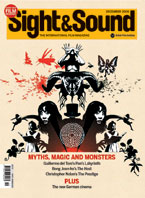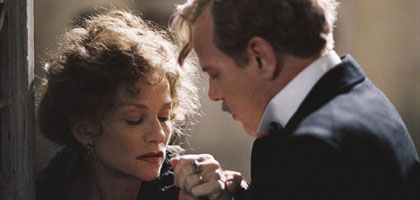Primary navigation


What happens when the foundations of a marriage are split apart? In Patrice Chéreau's artful reading of a Joseph Conrad novella, it's the images and silences that do the talking. By Robin Buss
Patrice Chéreau's latest film opens with the central character, a wealthy Parisian businessman, walking home from the station after a day at work shortly before World War I. As he goes, Jean Hervey recalls a dinner party the previous Thursday at which the discussion turned to the impossibility of truly knowing another person. Both Jean and his wife, settled into a bourgeois marriage of ten years, protest that it is possible: "I know her thoughts," Jean (Pascal Greggory) says of Gabrielle (Isabelle Huppert), while she responds by claiming that he is the only person she really does know, adding that this is enough for her. In this way, the dinner ironically announces what will be the guiding theme of the film, with all that follows offering extended proof of how untrue these two statements are (and so how little the two characters know themselves, let alone each other). Meanwhile, we catch a glimpse of the newspaper editor who will be the third person in the triangle, and hear Jean's disparaging opinion of him - a well-off businessman's view of a bohemian type, an editor who also writes poetry.
After this flashback Jean arrives home to a terrible surprise: Gabrielle has left him (for the poet-editor, as he will later discover). Then, while he is still digesting the brief letter revealing this news, the door opens and she comes back. During the rest of that evening and the following day, the couple are confronted with the implications of this event - and with the impossibility of understanding each other's feelings and motives.
This is essentially the same story as Joseph Conrad's novella The Return, but whereas Conrad is wordy, Chéreau's film is as economic and tightly structured as Bergman's Saraband. It falls into discrete but interlocking segments, some briefly in black-and-white, some with music, some without, depicting the confrontation between the Herveys against the background of upper-middle-class life in the belle époque. The couple, who have invested some surplus money in a newspaper, are the centre of an active social circle. Their regular Thursday receptions are like something out of Proust - or rather out of Raúl Ruiz's version of Proust in Le Temps retrouvé (in which Greggory also appeared).
Chéreau is one of the leading theatrical directors in France, having started while still at school with a production of a work by Victor Hugo, but he claims that his first love has always been cinema. He has a liking for literary adaptations: his debut film, Flesh of the Orchid (1974), was taken from a thriller by James Hadley Chase, and his first international success, La Reine Margot (1994), was an unusually bloodstained version of Alexandre Dumas' novel set at the time of the St Bartholomew's Day massacres in 1572. More recently, Chéreau has tended to prefer mood and psychology to violence, as in Ceux qui m'aiment prendront le train (1998), a melancholic study of family relationships, and Intimité (2000), adapted from Hanif Kureishi and set in London. Gabrielle is another such chamber piece.
The success of the film in France, where it topped the box office in its first weekend, shows there is still a large audience for the genre, despite the repugnance felt by many critics (and younger audiences) for period dramas, literary adaptations and anything that suggests theatricality. Like Chéreau himself, Greggory has a background in the theatre: he is excellent in certain roles and in this kind of film, but still has something of the presence of a stage performer. Huppert, too, in a different way, brings particular expectations to any role she takes. Both are very fine in this, and predictably so - because they both belong to that terrific pool of actors on which French directors are able to draw. But it is hard to forget that Huppert is Huppert.
Chéreau and scriptwriter Anne-Louise Trividic have clearly studied Conrad carefully and, while following the writer's basic premise quite closely, make a number of important additions and alterations. Seldom has an adaptation been quite so obviously a dialogue with its source material rather than a homage or reworking. There are details of the story that Chéreau translates precisely (such as the many mirrors, and their implications of narcissism, in Jean's dressing room), but he transposes the setting from London to Paris and boosts the social status of the two leads by a couple of notches. The Return is told almost entirely through the perceptions of the husband, who appears to live in a large house in one of Paris' more prosperous inner suburbs rather than the vast hôtel particulier of the film, with its numerous drawing rooms and its sweeping staircases decorated with many marble sculptures. The place is well supplied with servants (all female - a detail from Conrad, where it is explained as the wife's preference), and it takes three maids to dress Mrs Hervey for dinner.
The flashback to the opening dinner party is not in Conrad, but Chéreau has used it to balance a long sequence at the end of the film (which is in the novella) showing Jean watching as the maidservants go round the house turning off the lights, the gathering darkness expressing the closing down of avenues of escape or possibilities of salvation for the two main characters. "A vast melancholy as of mankind longing for what cannot be attained," Conrad says, adding much more about the "poignant futilities of life." The film makes its statement without words, through images, music and natural sound. Beautifully filmed by Eric Gautier, this is Gabrielle's finest passage and a demonstration of how a creative interpretation of a written source can inspire great cinema.
Chéreau's major addition to the story - apart from two sexual episodes, one active, one passive, both violent - is the way he develops the character of the wife, an almost silent presence in Conrad, refusing to answer her husband's demands for an explanation except, eventually, in gnomic phrases. Here, she reveals no more of her motives, at least in terms her husband would understand, but there is a long scene with her chambermaid that significantly shifts the focus of the narrative away from the man, with his apparent strengths and real weakness (the core of Conrad's story), to an element of their life Conrad takes for granted: the constant presence of silent others. ("No one must know, not even the servants!" he shouts at one point, loud enough for all the household to hear.) In a long added scene showing Gabrielle being undressed, the nature of her relationship with her maids becomes central; now she is the one who is talking and getting no response, as if she stood in the same relation to her chambermaid as her husband does to her.
In Chéreau's version, then, what was an episode in the war between men and women, which leaves her triumphant on the field, becomes much more a Huis clos, carrying the message that hell is the Other and inescapable for both of them - and probably, by implication, for all of us. It's as if the century since the novella was written had clarified its intentions, and this reading, tauter and more artfully constructed, says more in its relatively few words than Conrad's longwinded prose tale.